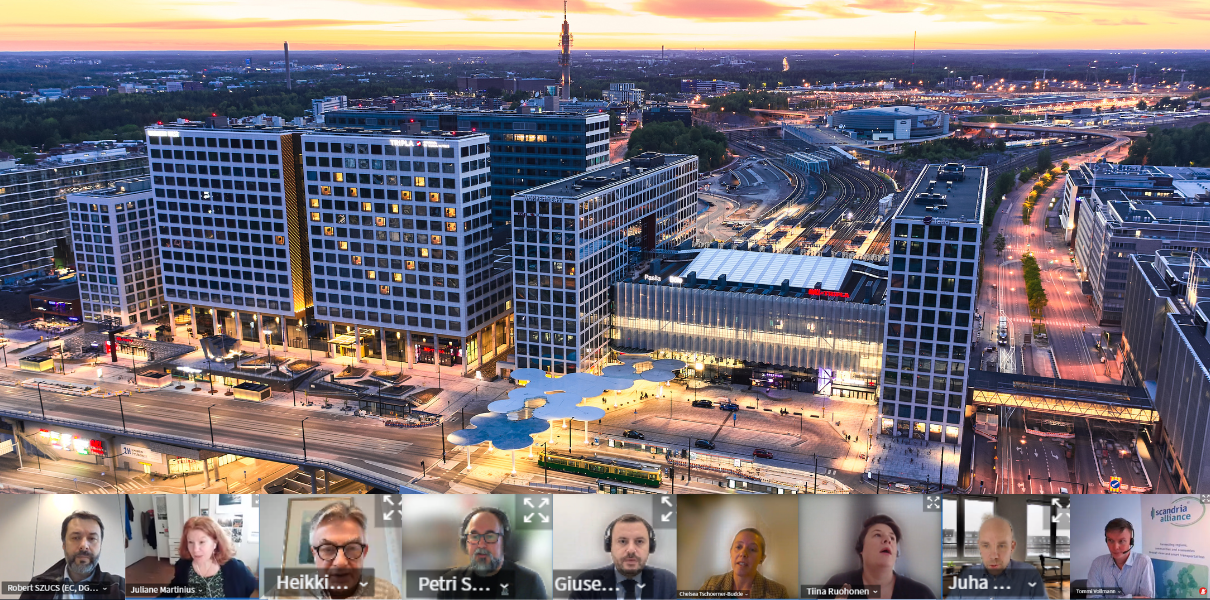The purpose of the webinar was threefold:
- to inform representatives of cities along the Scandinavian-Mediterranean Corridor about the upcoming requirements for urban nodes in the European Union’s new policy for the Trans-European Transport Network (TEN-T),
- to inspire participants by best-practice examples from our member regions, and
- to present preliminary findings from an interview series on the status quo of sustainable urban mobility planning in urban nodes of our member regions carried out by the Scandria Alliance task force on urban nodes.
The European perspective
Robert Szűcs, Policy Officer in the European Commission’ DG MOVE, presented the reinforced role of the urban nodes in the Commission’s proposal for a new TEN-T regulation. The Commission’s approach to look at urban nodes has developed from a linear approach to a place-based one due to the need to create better interactions between long-distance and urban transport as well as between different transport modes. Besides infrastructural requirements, the upcoming requirements for urban nodes will include the provision to set up a sustainable urban mobility plan (SUMP) and to report on sustainable urban mobility indicators (SUMI). There will be a SUMP training programme for all urban nodes organized by JASPERS in the years 2024 and 2025. Moreover, the Commission asks member states to provide support to their national urban nodes.
Sustainable urban mobility planning as a process
Most cities interviewed by the Scandria Alliance task force on urban nodes indicate that they already have a SUMP or a similar plan in place, but their level of detail and the degree to which cities have worked with the European SUMP guidelines differs greatly.
A recent example of an extensive SUMP process was presented by Juliane Martinius, head of unit “holistic transport strategies” in Hamburg’s Ministry of Transport and Mobility Transition. Hamburg’s strategy for mobility transition has just been adopted by Hamburg’s Senate in late November 2023. A key learning from Hamburg’s process is that a thorough coordination of and dialogue with all relevant actors and stakeholders as well as public participation processes require a lot of time and resources, but are worth the effort. To facilitate political decision-making, also scenario modelling proved to be an important tool. The strategy sets up the ambitious goal of an 80% share of sustainable modes of transport in Hamburg’s modal split by 2030. To reach this goal, ten key areas of action are defined. A massive expansion of the public transport offer (“Hamburg-Takt”) is the first of these action areas, which also contain push measures to achieve a re-allocation of space for busses, cyclists and pedestrians on a number of main roads. With the approach of offer-based planning, Hamburg turned the traditional planning approach of demand-based planning upside-down.
The functional urban area approach
One of the principles of the European SUMP guidelines is that SUMPs should ideally not only cover the area of the city itself, but take into the entire functional urban area, i.e. the city and its commuting zone. The interviews conducted by the Scandria Alliance revealed that there are only a few examples of SUMPs formally covering more than one municipality and that planning across municipal borders and cooperation and coordination with neighbouring remains a challenge. In Finnish city regions, we have seen exceptions with regional SUMPs in place that cover several municipalities.
Heikki Saarento, Planning Director at the Regional Council of Southwest Finland, provided insights into how the seven largest Finnish city regions work with integrated land use, housing and transport agreements, so-called a MAL agreements. These structural agreements are concluded between the state and municipalities to support and finance operative measures to achieve strategic goals that are integrated into regional transport system planning.
